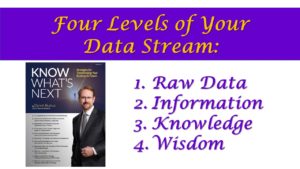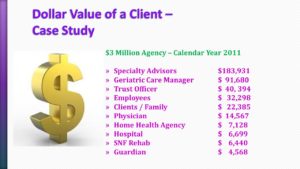By Stephen Tweed
How do you measure the success of your home care business?
What are the key metrics or KPI’s that you track in your business?
How do you use this information to make better business decisions?
Many years ago I was participating in the annual convention of the National Speakers Association, and my friend and professional speaking colleague, Daniel Burrus, CSP, CPAE, shared with us the four levels of your data stream: 
* data
* information
* knowledge
* wisdom
Data is simply bits and bytes stored in your computer. Data by itself is useless. Information is created when you organize data into some useful format. Then, when you analyze and synthesize your information you get knowledge. And knowledge, mixed with gray hair becomes wisdom. Wisdom is knowledge plus experience.
Top Tier Leaders use Data Oriented Decision Making
One of the lessons we’ve learned from working with our Top 5% Home Care Mastermind Group is that home care leaders in the top tier of our industry regularly use data, information, and knowledge to make business decisions that help them attract new clients, find and keep new caregivers, and grow their businesses. You can use these same systems to learn more and make better decisions in your business.
Some of the lessons we have learned from members who have tracked their own data are:
- Money matters more in recruiting and retention. By tracking the response to various types of job ads, we learned that job ads that mention money or benefits attract more applicants that other ads.
- You can improve your recruiting conversion by shortening your Speed to Hire. As members were struggling with no-shows for interviews, orientation, or first shifts, we learned that we could reduce no-shows and improve hiring conversion by shortening the length of time from when a caregiver submits an application until then are “shift ready”.
- You can Reduce overall caregiver turnover by improving 90-Day Retention. Data from Home Care pulse showed us that 57% of turnover happens in the first 90 days. Additional research at the Home Care CEO Forum showed us the three big causes of 90-Day turnover. We then learned how to balance the new caregiver’s expected take-home pay with their actual take-home pay and that dramatically improved 90-Day retention.
How to Master Your Own Data Stream
As your home care business grow, you’ll want to put more systems in place to use your data, information, and knowledge to grow your business. Here are four specific things you can do to master your own data stream.
- Capture All the Data – Begin by making sure that your office team members capture every transaction that takes place in your company in your scheduling software system. Every contact between the company and a client, a caregiver, or a referral source needs to be documented. If it’s not documented, it didn’t happen. The only way you can build your data stream is to gather every bit of data.
- Develop Regular Reports to turn Data into KPI’s. Set up systems so that every week your team members are tabulating raw data and putting that into a scorecard to track your KPI’s – Key Performance Indicators. Use those weekly reports in your regular meetings to measure performance and make decisions to improve performance or to solve problems.
- Analyze your Scorecard to develop knowledge of your operations. Use mathematical tools to organize and evaluate the information on your scorecard to guide a strategic decision.
- Use your experience and the experience of members of your mastermind group to turn your knowledge into wisdom.

My favorite example of this is when we developed a spreadsheet to calculate the dollar value of a client organized by referral. For one of our mastermind members, we developed a spread sheet with every client served during the year, their start of care date, their end of care date, and the dollars of revenue for each month. The we calculated the length of stay by months, and the average revenue per month. From that we were able to calculate the dollar value of each client – the revenue per month times the length of stay in months. Then we sliced and diced the spreadsheet and reorganized it by type of referral source. From that, we were able to calculate the average dollar value of a client by type of referral source.
The result was this list:
Let’s Discuss on Linked In
We’re introducing a new way to have an interactive discussion about the key points in our Home Care CEO Report articles. Take a few minutes to re-read the article. Then click on this link to Linked in, and let’s have a discussion.
How do you capture data in your business? 
How do you tabulate that data to get information?
How do you analyze and synthesize your information to gain knowledge of your business or our marketplace?
How do you combine your knowledge with your experience to gain wisdom?
Click the link above and let’s have a conversation on Linked In.
Explore Joining a Home Care CEO Mastermind Group
If you are the owner or CEO of a home care company providing 1,500 hours per week of care or more, you want want to explore becoming a member of a Home Care CEO Mastermind Group. Click the Link to set up conversation.




